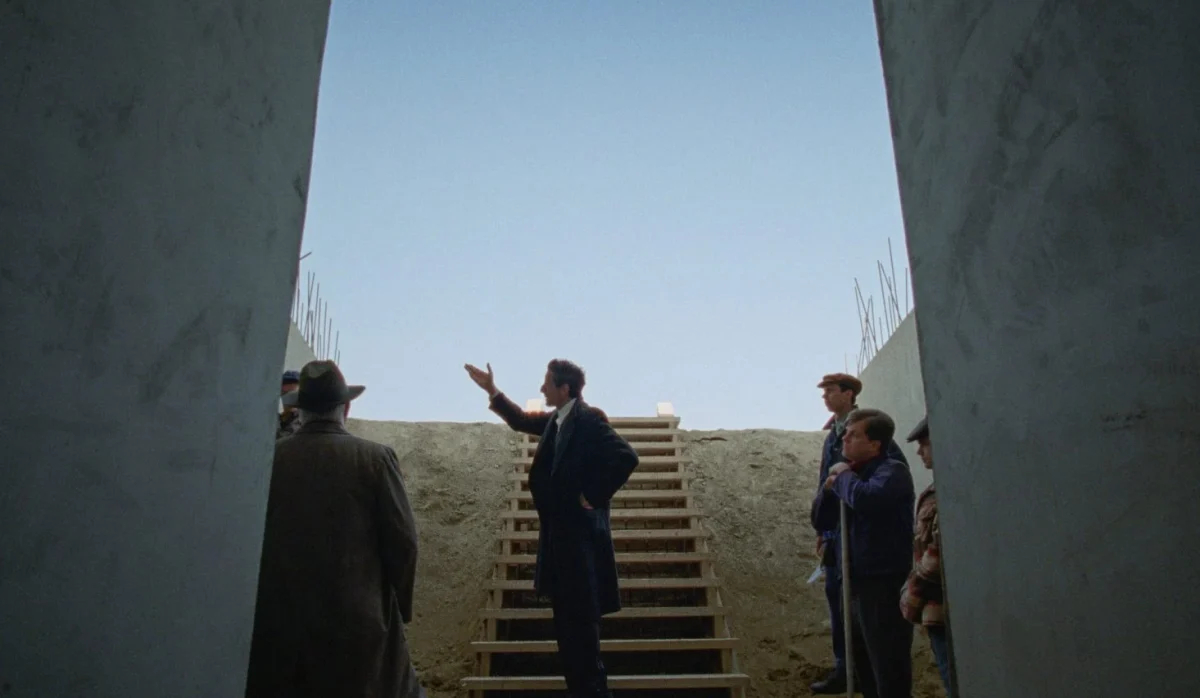Brady Corbet’s Oscar-nominated film The Brutalist is a gripping exploration of trauma and the reconstruction of memory through architectural expression. The film, with a runtime of three hours, is both a character study and a meditation on the nature of remembrance.
While the film takes its time building its characters, maintaining a minimalist style throughout, and features a stunning score, I will not focus on those elements here. Instead, I will discuss how the film portrays architecture as a ritualistic act of remembrance.
Through the story of László Tóth, a Hungarian-Jewish architect, The Brutalist presents the idea of anamnesis: the concept of memory whereby the past is drawn into the present day, but is also made real through ritual or proclamation, but also through physical representation, such as architecture. The notion of memory in the film is also one where we reconstruct the most monstrous realities– acknowledging their horror–in a way that allows for hope and connection.
The film begins with Tóth (Adrien Brody), a Bauhaus-trained architect who emigrates from Hungary to America, separated from the rest of his family. He works for his cousin designing furniture until things change and he is commissioned to construct a library for a wealthy businessman, Harrison Lee Van Buren (Guy Pearce).
As Tóth begins to design a library for the new project, we see the first hints of his Brutalist style. After being fired and then rehired by Van Buren, Tóth is commissioned to design and lead the construction of a community center.
The first half of the film delves into Tóth’s struggles in his new environment—the Van Buren manor—where he is treated like a lapdog by the filthy rich.
After the fifteen-minute intermission, we are introduced to the rest of Tóth’s family, who have managed to escape Europe and are now staying with him in the Van Buren manor. The second half of the film follows Tóth’s new project, the community center and his relationship with his wife, Erzsébet (Felicity Jones).
We learn that Tóth was in Birkenau and his wife was in Dachau. The wounds are not only scarred reminders of the past but also actively persisting; the pain is remembered but also present. Their love is so bound up, connected, and tangled, and yet also tortured by their collective and respective trauma. There is much love but so much brokenness.
While Tóth initially resists the idea of a religiously themed community building, arguing that a true community center cannot be dedicated to one faith, this resistance marks the beginning of a transformation in Tóth’s design.
Tóth’s obsession with the building grows. As the project progresses and the structure becomes alive, it represents the concept of anamnesis. We start to see Tóth’s personal history and trauma seep into the building’s design, transforming it into something deeply personal—both a way for him to confront and redeem his past and a recreation of it in present concrete form—a kind of holy remembrance that remakes and redeems.
The center becomes more than a religious space; it becomes a vessel for Tóth’s own act of anamnesis, a physical space where memory and trauma can be brought into the present and made real. Tóth carries the memory and all that it entails inside himself. He expresses these memories in his craft, in his design, in the form, and especially in his architecture, particularly in the towering ceiling of Birkenau.
Tóth is the brutalist, both as an architect in a particular style but also as a Jew who experienced horror and trauma through the Holocaust. He is a character who ultimately finds a way to remember and transform the past through his creative expressions, to allow for hope and connection in a reality that had only dehumanized and separated and ravaged individuals and destroyed families. He remakes his life through his architecture.
In the last ten minutes of the film, time passes, and Tóth is now seen as an old man. Rolled into a room at the Venice Biennale in his wheelchair, Tóth and a crowd of people listen as his niece acknowledges his architectural works and their legacy.
She describes his many buildings in the Brutalist style and their inspiration drawn from his time in Birkenau. “Connected by secret corridors, rewriting their history, transcending space and time,” speaks to how Tóth’s designs bridge the past and present, offering a sense of continuity that goes beyond traditional boundaries.
While rooted in shared horror, these tunnels—interconnected—now act as a chance for hope and connection rather than resistance and survival. These “secret corridors” become metaphors for invisible threads that link generations, subtly shaping the future and carrying the weight of history.
The Brutalist is an immense, unyielding visual experience about the making of an immense, unyielding architectural masterpiece.
The Brutalist architectural style reflects Tóth and his need to build something that can carry the weight of his trauma. The style is not just a creative choice; it is a form of remembrance.
Tóth’s buildings are spaces where the past is not buried but actually made present through their form and structure.




